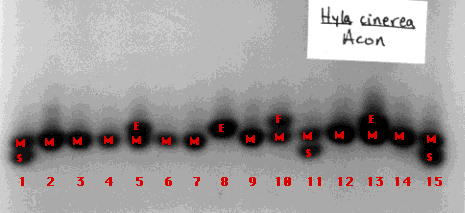| Index to this page |
A polymorphism is a genetic variant that appears in at least 1% of a population.
Examples:| Link to an example |
| Link to description of electrophoresis. |
Enzymes are frequently polymorphic. A population may contain two or more variants of an enzyme encoded by a single locus. The variants differ slightly in their amino acid sequence and often this causes them to migrate differently under electrophoresis. By treating the gel with the substrate for the enzyme, its presence can be visualized.

Here is an example (courtesy of Susan McAlpine).
Electrophoresis of tissue extracts from 15 different green treefrogs (Hyla cinerea) reveals 4 allelic versions of the enzyme aconitase (one of the enzymes of the citric acid cycle). The 4 alleles can be distinguished by the speed with which their protein product migrates:Proteins are gene products and so polymorphic versions are simply reflections of allelic differences in the gene; that is, allelic differences in DNA.
Often these changes create new — or abolish old — sites for restriction enzymes to cut the DNA. Digestion with the enzyme then produces DNA fragments of a different length. These can be detected by electrophoresis.
RFLPs are discussed in greater detail in a separate page.| Link to it. |
| (* but not all; link to an example of a RFLP caused by a deletion.). |
SNPs
As of October 2005, over one million SNPs had been identified across the human genome. [Link to the HapMap project]
Genetic analysis (using DNA chips and FISH) has revealed another class of human polymorphisms. These copy number polymorphisms are large (thousands of base pairs) duplications or deletions that are found in some people but not in others. On average, one person differs from another by 11 of these. One or more have been found on most chromosomes, and the list is probably incomplete.
While most of this DNA is non-coding, functional genes are embedded in some of it. Example: AMY1, the gene encoding salivary amylase, an enzyme that digests starch. Humans vary in the number of copies of AMY1 in their genome.
In the case of AMY1, the more copies present, the more enzyme that is produced. How a person adapts to a change in gene number for autosomal genes is unknown (in contrast to the way that human females adjust the activity of the genes on their two X chromosomes to match that of males with their solitary X chromosome - Link).
| Link to illustrated discussion. |
They arise by mutation.
But what keeps them in the population?
Several factors may maintain polymorphism in a population.In the 1680s Adriaantje Ariens and Gerrit Jansz emigrated from Holland to South Africa, one of them bringing along an allele for the mild metabolic disease porphyria. Today it is estimated that more than 30,000 South Africans carry this allele and, in every case examined, can trace it back to this couple — a remarkable example of the founder effect.
The effect, called random genetic drift, is particularly strong
Eventually the entire population may become homozygous for the allele or — equally likely — the allele may disappear. Before either of these fates occurs, the allele represents a polymorphism.
Two examples of reduced polymorphism because of genetic drift:
Hence the relatively high frequency of the allele in malarial regions.
| View the structure of the two alleles and their products. |
When natural selection favors heterozygotes over both homozygotes, the result is balanced polymorphism. It accounts for the persistence of an allele even though it is deleterious when homozygous.
Homozygosity for either allele increases the susceptibility to prion diseases. People who are heterozygous are more resistant.
A study of elderly women who had survived the kuru epidemic of the first half of the 20th century (eating the tissues of the deceased was banned in 1950) showed that 76.7% of them were heterozygotes. This table compares the gene frequencies in this population as well as in a population that never practiced mortuary feasts.
M is the allele encoding the methionine; V the allele encoding valine.
| MM | MV | VV | |
| Survivors | 0.133 | 0.767 | 0.100 |
| Unexposed | 0.221 | 0.514 | 0.264 |
A quick calculation will show that the gene pool of the exposed women deviates widely from what would be found if the population were in Hardy-Weinberg equilibrium. In this case, strong mortality selection is the cause. The gene pool of the unexposed population is close to being in Hardy-Weinberg equilibrium.
Here, again, natural selection has favored heterozygotes over both homozygotes (and led to the speculation that cannibalism may have been common earlier in human history) [Link].
Hirta is a tiny island in the North Atlantic 100 miles off the northwest coast of Scotland. In 1932 a small (107) population of domestic sheep (Ovis aries) was introduced onto the island from the neighboring island of Soay. Since then these sheep have been allowed to run wild and, since 1985, have been intensively studied.
The sheep have horns and, in males, these play an important role in competition for females. The size of the horns is strongly influenced by a single gene locus, RXFP2, with two alleles: Ho+ and HoP.You can read about these findings in Johnston, Susan. E., et al., Nature 502, 93–95, 3 October 2013.
| Welcome&Next Search |